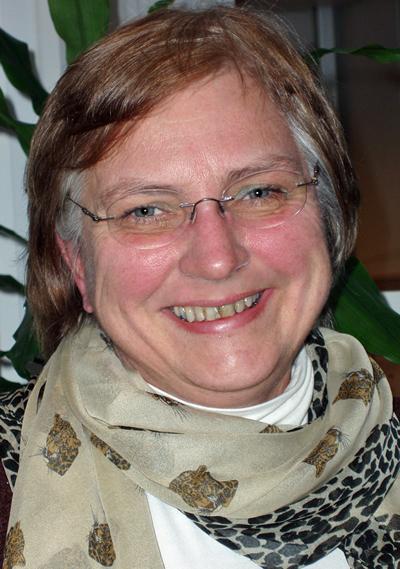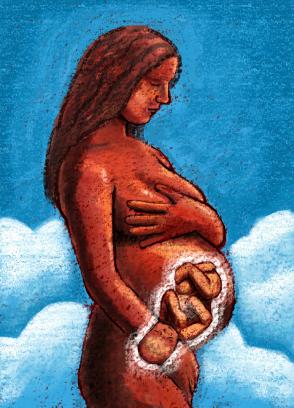
– We know what needs to be done to prevent women from dying in connection with pregnancy, birth and abortion. Nevertheless, the rate of maternal mortality is still sky high in many countries. The reason why so little is done is a mystery, as it should be in everyone’s interests to improve this situation, says the doctor from the Health and AIDS Department of the Norwegian Agency for Development Cooperation (NORAD). She has recently seen the publication of her book ”Kvinners helse på spill: Et historisk og globalt perspektiv på fødsel og abort” (Women’s health at risk: A historic and global perspective on birth and abortion). In the book she sums up research on women’s reproductive health. In addition, she uses illustrations and examples based on her own experience as a practising doctor and expert in community medicine associated with NORAD and the United Nations Population Fund.
Austveg wants to reach a larger public, those with experience of community medicine, about a topic she believes is important, both on the human level and politically.
– This is an unbelievably fascinating field. Reproduction affects all people, on an existential level. And it affects the whole of society at many different levels, in families, in the local community and nationally. Not least, reproduction is an important topic in global politics, which is closely connected with attitudes towards women and women’s status.
– In the1960s and 1970s, the bearing of children was associated with the “population explosion”, and it was conceived as “the greatest threat to human existence”. Fortunately, that monstrous way of thinking was abandoned.
One in seven
The population conference in Cairo in 1994 represented a shift in the direction of a political discourse to one that is more sympathetic towards women, and in which the focus shifted from controlling the growth of populations to a securing of individuals’ rights to reproductive health, explains Austveg. In 2000, the UN singled out the reduction of maternal mortality as one of eight Millennium Development Goals.
In many countries pregnancy is associated with great risk. The more pregnancies per woman, the greater the risk that a woman will eventually die from one of her pregnancies. Maternal mortality is at its highest in Somalia and Sierra Leone, where one in seven women die from pregnancy related causes. Among the most common causes are preeclampsia, haemorrhage and infections.
– This is a paradox: Pregnancy is completely natural, but at the same time it is always connected with risk, says Austveg.
But research shows that the risk can be minimised through access to qualified midwives and safe abortions. In case there is no health service available, one in a hundred births will lead to the death of the woman, explains Austveg. 15 per cent of women giving birth require assistance.
– No one knows before hand who will need help. Therefore, having help available for everyone is crucial for preventing illness and death.
Contempt for women
In Norway, a good health service ensures that maternal mortality is as low as possible. However, not all societies have this tradition of assisting women when they are pregnant and give birth. Neither can it be taken for granted that a society which has an otherwise well functioning health service will prioritise problems connected with reproduction.
– In many instances, the lack of a good midwife service is, in reality, a contempt for women. There is a clear relationship between the general status of women in a society and the health service available for pregnant women and for childbirth, Austveg states. She names Sri Lanka, a country in which she has lived and worked, as an example. Here, women have a relatively high status, compared with India. Pregnancy related deaths are also significantly lower in Sri Lanka than in the neighbouring country.
Social Injustice
Austveg has spent a great deal of time wondering why so little is done to reduce the maternal mortality rates of many countries around the world, in spite of the presence of relevant expertise and the correct political rhetoric.

– Perhaps it’s something as simple as the fact that the ruling classes are not affected by this problem? Maternal mortality affects only women, and first and foremost poor women. It in is this context that Austveg describes maternal mortality as the greatest social injustice in the world.
The injustice becomes particularly true in cases of unplanned and unwanted pregnancies. On a global basis, 13 per cent of maternal deaths are connected with abortions. In Catholic countries that have restrictive abortion laws, the figure is a high as 50-60 per cent. The stricter the abortion legislation, the higher the number of abortion related deaths, according to Austveg.
Abortions in all societies
In her book Austveg describes sharp divides in all global arenas where reproduction and sexuality are discussed. Abortion, and adolescent sexuality, are the most controversial topics today. Norway has been an important voice in working towards ensuring safe abortions for all women. However, powerful forces are working in the opposite direction. The USA in alliance with Catholic countries are unbending in their policy – urging sexuality abstinence as the only right. “Ostrich politics”, says Austveg, referring to the bird’s mythical habit of burying its head in the sand.
– Women in all societies in the world have abortions, and they have always done so. That’s a fact. By closing one’s eyes to this, one accepts that women will die from a surgical procedure that, if carried out properly, constitutes only a minimal risk, says Austveg.
It is poor women who have the most risky abortions.
– Rich women can buy safe abortions anywhere in the world. This social difference is unacceptable. Nobody says out loud that it is okay that poor people die. But this is the consequence when women have to subject themselves to dangerous abortions in order to end unwanted pregnancies, Austveg says.
A huge advantage
It is just not possible to be completely rid of unwanted pregnancies, underlines Austveg. In an ideal situation, in which everyone had access to contraception, 20 million women would still become pregnant each year, against their wishes. Since unwanted pregnancies are something that we just have to accept, providing safe abortions is a condition for realising gender equality, according to Austveg.
– Achieving gender equality is completely impossible as long as sexual activity constitutes a risk to the health of one party. That women are risking so much and men so little constitutes a huge advantage for men.
Translated by Matthew Whiting KILDEN
- Mother mortality is a collective term for the deaths of women caused by pregnancy, birth or abortion.
- In the year 2000 more than a half million women died from causes related to pregnancy (WHO).
- Mother mortality is 20 times higher in Africa than it is in the developed world.
- Reducing mother mortality is one of the UN's 8 Millenium Development Goals.